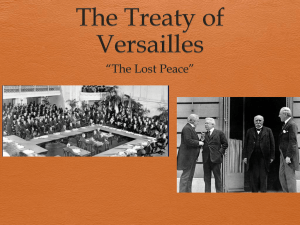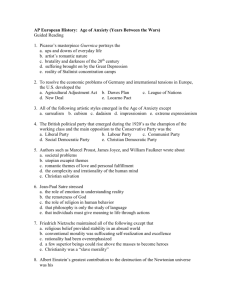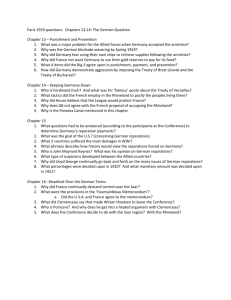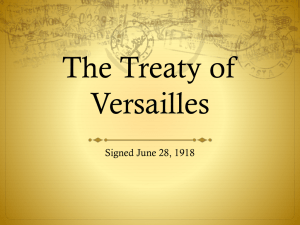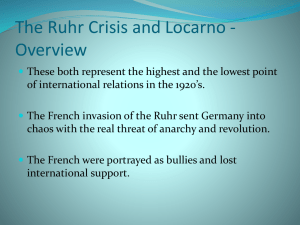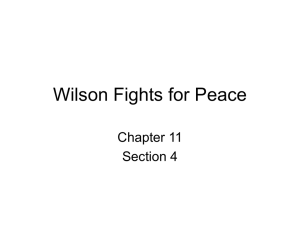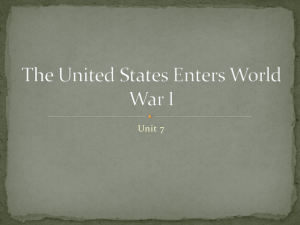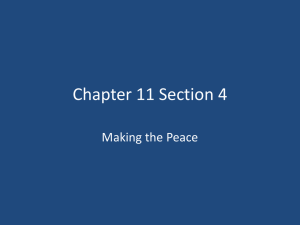The Ruhr Crisis, Locarno, and the Locarno Spring
advertisement
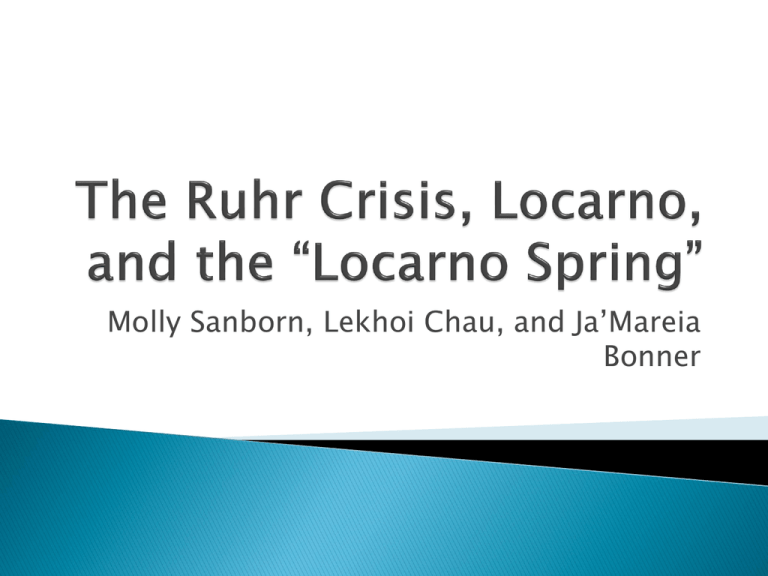
Molly Sanborn, Lekhoi Chau, and Ja’Mareia Bonner France disagreed with Britain on how Germany should be treated after World War I. France wanted to weaken the German economy through heavy reparations. ◦ France needed these reparations to pay back its debt to the United States. ◦ 132 billion gold marks were to be paid to the Allied powers. France was afraid for its security. ◦ The Anglo-American Guarantee was denied. ◦ It did not want to be susceptible to future German attacks. Britain felt that Germany’s treatment at the Paris Peace Conference was too harsh. The reparations that Germany was being forced to pay would cripple its economy. Germany was the economic engine of Europe, therefore a crippled Germany would result in a weak European economy. If the harsh treatment of Germany continued, it might become closer to Russia. Germany missed a shipment of timber as part of its reparation payments to France. Despite British objections, France and Belgium invaded the Ruhr on January 11, 1923. ◦ The goal was to collect the missed reparation payments by force. ◦ Mines and factories were seized by French and Belgium troops. German workers refused to co-operate with the French troops. Instead, they revolted against them. ◦ They destroyed mines, factories, and goods. ◦ Violence broke out between protestors and troops. The Weimar Government attempted to support its workers. ◦ It printed more paper money, which depreciated its value. ◦ Everyday goods cost billions of marks. The middle class was hit the hardest. ◦ All of their savings were wiped out. ◦ They became cynical and pessimistic about the future. ◦ This led to susceptibility to extremists like Hitler. The Allies saw that the German economy and government were close to completely collapsing. ◦ Collapsed Germany meant no reparation payments and a failing European economy. ◦ Anarchy could ensue, which could lead to the embrace of communism. During World War I, the exchange rate between the German mark and the U.S. dollar fell. By 1919, it was 47 marks to the dollar. Reparation payments were to begin in June 1921. ◦ Payments were to be 2 billion gold marks, plus 26% of German exports per year. ◦ This led to rapid devaluation of the German mark to approximately 330 marks to the dollar by November 1921. Germany began buying foreign currency, which increased the devaluation of the mark. By December 1922 the value fell to 8,000 marks to the U.S. dollar. French and Belgian troops invaded the Ruhr – Germany’s industrial region – to collect reparations in the form of goods. ◦ The mark was essentially worthless at this time, so France was looking for another method of payment. The inflation was aggravated when the Weimar government printed more paper marks to support its passively resisting workers. A political cartoon showing the overprinting of marks during the Great Inflation. A chart showing the inflation of the German mark from the end of World War I to 1923. Gustav Stresemann was appointed as the Chancellor of Germany in 1923. He implemented the Policy of Fulfillment. ◦ His goal was for Germany to reclaim a respected place in the world. This policy supported German co-operation with the Treaty of Versailles. ◦ The goal was to receive concessions in the future from the Allies. Passive resistance was called off in the Ruhr. This policy was meant to show the Allies that Germany deserved a revision to the Treaty of Versailles due to its good behavior and cooperation. The United States was the wealthiest nation in the world during this time. French and British debts to the U.S. were being paid back through the collection of reparations from Germany. Charles Dawes developed a plan for economic relief. The Dawes plan rescheduled Germany’s reparation payments. ◦ The deadlines were longer and the amount decreased. ◦ American capital went into German businesses and government bonds. A diagram depicting the exchange of money in the Dawes Plan. The initial meeting took place in Locarno, Italy in September 1925. It was formally signed in London in December 1925. It involved Germany, Britain, France, Belgium, and Italy. Germany agreed to accept its borders with France and Belgium as permanent. ◦ The borders were to be guaranteed by Britain and Italy. Germany was allowed to join the League of Nations. Germany’s eastern borders were not fixed. ◦ Britain would not guarantee these countries. ◦ Germany agreed to seek border changes with Poland and Czechoslovakia through discussion instead of violence. This was a good opportunity for France and Germany to reconcile. Germany could now rebuild its economy. ◦ It was not a threat to European safety. Britain and France could repair their relations. ◦ Had drifted apart over the issue of the treatment of Germany. The Locarno Treaty promoted optimism throughout Europe. It inspired a spirit of co-operation and peace. A cartoon by David Low showing Aristide Briand, Austin Chamberlain and Gustav Stresemann signing the Locarno Treaty (1925). Allied troops were removed from the Rhineland. Allied supervision of German disarmament stopped in 1927. Tensions between Germany and the Allies were on the way to becoming resolved. ◦ Germany was treated more like an equal and less like a criminal. This provided an opportunity for France to repair its relationship with its former allies the United States and Britain. Germany had a more active role in European politics through its membership in the League of Nations. Peace in Europe seemed to be achievable. Under the Treaty of Rapallo, Germany was still co-operating with the Soviet Union. ◦ This meant that Germany could avoid its disarmament. Germany’s eastern border with Czechoslovakia and Poland had not been fixed under the Locarno Treaty. ◦ Germany’s relationship with the Soviet Union was dangerous because the Soviet Union wanted to redraw the borders of Eastern Europe. The League of Nations and collective security were not strengthened. ◦ In theory, peace could be achieved, but in reality it was not likely. http://www.ibguides.com/history/notes/theruhr-crisis-1923-locarno-and-the-locarnospring http://ibhistory.wikidot.com/the-ruhr-crisis1923-locarno-and-the-locarno-spring-1925 http://ibhistory2012.wikia.com/wiki/Locarno _and_the_Locarno_Spring-_Artmis_Rahbar
